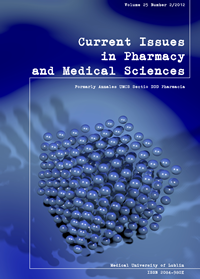Detection, genotyping and phylogenesis of human papillomavirus (HPV) and Epstein-Barr virus (EBV) in patients with lung cancer
DOI:
https://doi.org/10.12923/j.2084-980X/25.2/a.10Keywords:
lung cancer, human papillomavirus, Epstein-Barr virus, sequencing, phylogenetic treeAbstract
The lung cancer is one of the most common cancers in humans. It is now believed, that the most common cause of this disease is smoking, nevertheless also research on oncogenic viruses participating in the development of this type of tumor confirms that. Human papillomavirus (HPV) and Epstein-Barr virus (EBV) are the etiologic agents of several types of cancer. The dynamic development of molecular biology techniques and bioinformatics allows for the genotyping of microorganisms in a more accurate and reliable way. In this paper, we carried out the detection and genotyping of HPV and EBV in fragments of fresh tissue obtained from patients with the lung cancer. In addition, typing results are presented graphically in phylogenetic trees.
References
1. Aguayo F. et al.: Human papillomavirus-16 presence and physical status in lung carcinomas from Asia. Infectious Agents and Cancer, 5, 20, 2010.
2. Alberg AJ, Samet JM: Epidemiology of Lung Cancer. Chest, 123, 2003.
3. Alipov G et al.: Epstein-Barr virus-associated gastric carcinoma in Kazakhstan. World J. Gastroenterol., 11, 1, 2005.
4. Bernard H.U. et al.: Classification of papillomaviruses (PVs) based on 189 PV types and proposal of taxonomic amendments. Virology, 401, 2010.
5. Bos D.H., Posada D.: Using models of nucleotide evolution to build phylogenetic trees. Dev. Comp. Immunol., 29, 2005.
6. Bottalico D. et al.: Characterization of human papillomavirus type 120 (HPV120): a novel Betapapillomavirus with tropism for multiple anatomic niches. J. Gen. Virol., 5, 2012.
7. Bravo I.G., de Sanjose S., Gottschling M.: The clinical importance of understanding the evolution of papillomaviruses. Trends Microbiol., 18, 10, 2010.
8. Brouchet L. et al.: Detection of oncogenic virus genomes and gene products in lung carcinoma. Brit. J. Cancer, 92, 2005.
9. Chen M.R.: Epstein–Barr virus, the immune system, and associated diseases. Frontiers in Microbiology, 2, 5, 2011.
10. Chu P.G. et al.: Epstein–Barr virus plays no role in the tumorigenesis of small-cell carcinoma of the lung. Mod. Pathol., 17, 2004.
11. Coissard C.J. et al.: Prevalence of human papillomaviruses in lung carcinomas: a study of 218 cases. Modern Pathol., 18, 2005.
12. Conway E.J. et al.: Absence of evidence for an etiologic role for Epstein-Barr virus in neoplasms of the lung and pleura. Mod. Pathol., 9, 5, 1996.
13. Cornut G. et al.: Polymorphism of the Capsid L1 Gene of Human Papillomavirus Types 31, 33, and 35. J. Med. Virol., 82, 2010.
14. Correa R.M. et al.: Epstein Barr Virus Genotypes and LMP-1 Variants in HIV-Infected Patients. J. Med. Virol., 79, 2007.
15. Criscuolo A., Gascuel O.: Fast NJ-like algorithms to deal with incomplete distance matrices. BMC Bioinformatics, 9, 2008.
16. Giuliani L. et al.: Detection of oncogenic viruses (SV40, BKV, JCV, HCMV, HPV) and p53 codon 72 polymorphism in lung carcinoma. Lung Cancer, 57, 2007.
17. Guindon S., Gascuel O.A.: Simple, Fast, and Accurate Algorithm to Estimate Large Phylogenies by Maximum Likelihood. Syst. Biol., 52, 2003.
18. Haley S.A. et al.: Unique susceptibility of a human lung carcinoid tumor cell line to infection with BK virus. Virus Res., 149, 2010.
19. Higgs P.G., Attwood T.K. (2004). Bioinformatics and Molecular Evolution. New Jersey: Wiley-Blackwell.
20. Holder M., Lewis P.O.: Phylogeny Estimation: Traditional and Bayesian Approaches. Nat. Rev. Genet., 4, 2003.
21. Hsu N.Y. et al.: Association between expression of human papillomavirus 16/18 E6 oncoprotein and survival in patients with stage I non-small cell lung cancer. Oncol. Rep., 21, 2009.
22. Kolaczkowski B., Thornton JW: Performance of maximum parsimony and likelihood phylogenetics when evolution is heterogeneous. Nature, 431, 2004.
23. Lim W.T. et al.: Assessment of human papillomavirus and Epstein-Barr virus in lung adenocarcinoma. Oncol. Rep., 21, 2009.
24. Pan S.H. et al.: Epstein-Barr virus nuclear antigen 2 disrupts mitotic checkpoint and causes chromosomal instability. Carcinogenesis, 30, 2, 2009.
25. Peh S.C. et al.: Epstein-Barr virus (EBV) Subtypes and Variants in Malignant Tissue from Malaysian Patients. J. Clin. Exp. Hematopathol., 43, 2, 2003.
26. Picconi M.A. et al.: Human Papillomavirus Type-16 Variants in Quechua Aboriginals from Argentina. J. Med. Virol., 69, 2003.
27. Saitou N., Nei M.: The Neighbor-joining Method: A New Method for Reconstructing Phylogenetic Trees. Mol. Biol. Evol., 4, 1987.
28. Syrjänen K.J.: Condylomatous changes in neoplastic bronchial epithelium. Report of a case. Respiration, 38, 5, 1979.
29. Tiwawech D. et al.: Association between EBNA2 and LMP1 subtypes of Epstein-Barr virus and nasopharyngeal carcinoma in Thais. J. Clin. Virol., 42, 2008.
30. Winder D.M. et al.: Sensitive HPV detection in oropharyngeal cancers. BMC Cancer, 9, 440, 2009.
31. Yu Y. et al.: Correlation of HPV-16/18 infection of human papillomavirus with lung squamous cell carcinomas in Western China. Oncol. Rep., 21, 2009.
32. Zafer E. et al.: Detection and Typing of Human Papillomavirus in Non-Small Cell Lung Cancer. Respiration, 71, 2004.
Downloads
Published
Issue
Section
License
Copyright (c) 2012 Authors

This work is licensed under a Creative Commons Attribution-NonCommercial-NoDerivatives 3.0 Unported License.


